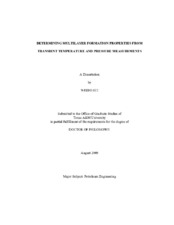| dc.contributor.advisor | Ehlig-Economides, Christine | |
| dc.contributor.advisor | Zhu, Ding | |
| dc.creator | Sui, Weibo | |
| dc.date.accessioned | 2010-10-12T22:31:29Z | |
| dc.date.accessioned | 2010-10-14T16:02:05Z | |
| dc.date.available | 2010-10-12T22:31:29Z | |
| dc.date.available | 2010-10-14T16:02:05Z | |
| dc.date.created | 2009-08 | |
| dc.date.issued | 2010-10-12 | |
| dc.date.submitted | August 2009 | |
| dc.identifier.uri | https://hdl.handle.net/1969.1/ETD-TAMU-2009-08-7059 | |
| dc.description.abstract | The Multilayer Transient Test is a well-testing technique designed to determine
formation properties in multiple layers, and it has been proved effective during the past
two decades. To apply the Multilayer Transient Test, a combination of rate profiles from
production logs and transient rate and pressure measurements are required at multiple
surface rates. Therefore, this method can be time consuming and may involve significant
errors due to inaccurate transient flow rate measurements. A new testing approach is
proposed after realizing the limitations of the Multilayer Transient Test. The new testing
approach replaces the transient flow rate measurement with transient temperature
measurement by using multiple temperature sensors. This research shows that formation
properties can be quantified in multiple layers by analyzing measured transient
temperature and pressure data.
A single-phase wellbore/reservoir coupled thermal model is developed as the
forward model. The forward model is used to simulate the temperature and pressure
response along the wellbore during the transient test. With the forward model, this work
proves that the transient temperature and pressure are sufficiently sensitive to formation
properties and can be used for multilayer reservoir characterization.
The inverse model is formulated by incorporating the forward model to solve
formation properties using nonlinear least-square regression. For the hypothetical cases,
the proposed new multilayer testing method has successfully been applied for
investigating formation properties in commingled multilayer reservoirs. Layer permeability, damaged permeability, and damaged radius can be uniquely determined
using single-point transient pressure data and multipoint transient temperature data at
appropriate locations. Due to the proposed data acquisition scheme, only one surface
flow rate change is needed to implement this testing approach, which significantly
reduces the test duration compared to the standard multilayer transient testing approach
using a series of flow rate changes. Of special interest, this is the first test design that
shows promise for determination of the damaged radius, which can be useful for well
stimulation design. In addition, temperature resolution, data noise, and data rate impacts
have been studied along with a data filtering approach that enable selection of suitable
pressure and temperature sensor technologies for applying the new testing method. | en |
| dc.format.mimetype | application/pdf | |
| dc.language.iso | en_US | |
| dc.subject | multilayer reservoir characterization | en |
| dc.subject | downhole monitoring | en |
| dc.subject | transient temperature interpretation | en |
| dc.subject | pressure and temperature gauge | en |
| dc.title | Determining Multilayer Formation Properties from Transient Temperature and Pressure Measurements | en |
| dc.type | Book | en |
| dc.type | Thesis | en |
| thesis.degree.department | Petroleum Engineering | en |
| thesis.degree.discipline | Petroleum Engineering | en |
| thesis.degree.grantor | Texas A&M University | en |
| thesis.degree.name | Doctor of Philosophy | en |
| thesis.degree.level | Doctoral | en |
| dc.contributor.committeeMember | Hill, Daniel A. | |
| dc.contributor.committeeMember | Efendiev, Yalchin | |
| dc.type.genre | Electronic Dissertation | en |
| dc.type.material | text | en |


